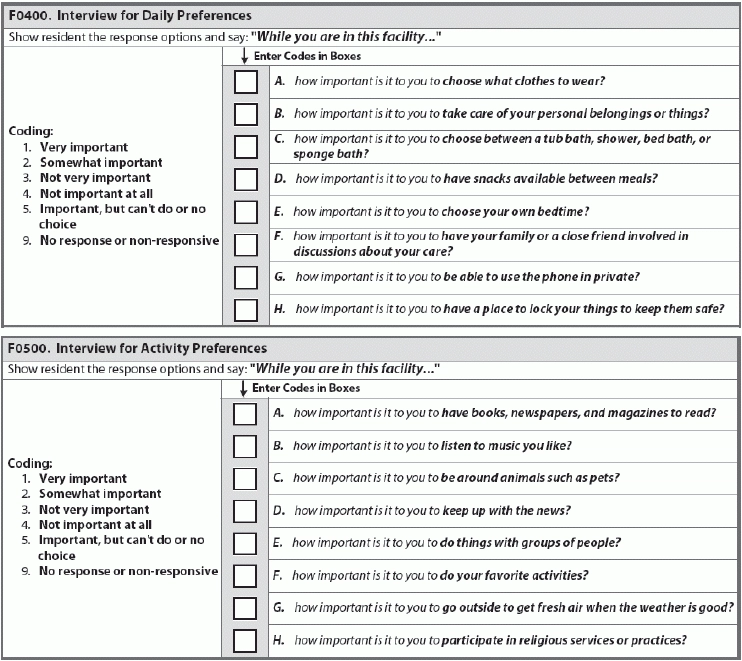Learn why these interview responses are important to care planning.
When coding item F0400 — Interview for Daily Preferences, you can easily misinterpret what a resident is trying to convey. Like other interview items in the MDS, you need to follow specific instructions to get the coding right. Here are a few tips to help you do just that:
1. Set the Stage for the Interview
Before you begin the Interview for Daily Preferences, you should select a private setting to conduct the interview and sit so that the resident can see your face clearly, with adequate lighting that minimizes glare. Also, make sure the resident can hear you. Use the resident’s usual communication devices or techniques if he has a hearing impairment.
Keep background noise to a minimum. Try using headphones, a hearing amplifier, or another external assistive device if you have any doubt about the resident’s ability to hear you.
Don’t forget: At the start of the interview, you should first explain to the resident the reason for the interview. The RAI Manual suggests the following language:
“I’d like to ask you a few questions about your daily routines. The reason I’m asking you these questions is that the staff here would like to know what’s important to you. This helps us plan your care around your preferences so that you can have a comfortable stay with us. Even if you’re only going to be here for a few days, we want to make your stay as personal as possible.”
Also, explain each response choice to the resident. Show the written responses and use cue cards. Allow residents to respond to the interview questions verbally, by pointing to their answers on a cue card, or by writing out their answers.
2. Know When to Code 9
If a resident cannot or will not communicate his preferences, then you should interview family members and/or a significant other. Keep in mind that the F0400/F0500 interviews are the only ones in the MDS that do not rely solely on a resident’s self-reporting, notes Kris Mastrangelo, President and CEO of Harmony Healthcare International.
You should code 9 — No response or non-responsive in only three specific situations:
If the resident gives nonsensical answers or fails to respond to three or more of the 16 items in F0400 and F0500 — Interview for Activity Preferences, you would consider the interview as incomplete. In this case, you should fill in the remaining F0400 and F0500 items with a 9 — No response or non-responsive and continue on to item F0600 — Daily and Activity Preferences Primary Respondent.
3. Remember to Use ‘Echoing’ Technique
But don’t discount the resident’s response if it makes sense but is long-winded. Residents may give long or indirect answers to interview items, and in these cases you should try to summarize their answer and ask which response option best applies, the RAI Manual instructs. This technique is called “echoing.”
Example: You ask the resident, “How important is it to you to choose what clothes to wear (including hospital gowns or other garments provided by the facility)?” to code item F0400A. The resident responds, “I leave that up to the nurse. You have to wear what you can handle if you have a stiff leg.”
What to do: In this case, you should echo: “You leave it up to the nurses. Would you say that, while you’re here, choosing what clothes to wear is [pointing to the cue card] very important, somewhat important, not very important, not important at all, or that it’s important but you can’t do it because of your leg?”

The resident replies, “Well, it would be important to me, but I just can’t do it.” In this scenario, you would code item F0400A as 5 — Important, but can’t do or no choice.
The interview process aims to encourage residents to make their voices heard during the care planning process, Mastrangelo stresses. This also provides an opportunity for staff to really evaluate any concerns a resident might have so they can provide more resident-specific care and boost residents’ satisfaction with their stay at the facility.
4. Leverage Responses to Enhance Care Planning
You should use the Interview for Daily Preferences as a first key step in care planning for a resident, according to the RAI Manual. Care planning based on resident preferences can improve a resident’s mood, enhance his dignity, and increase his involvement in daily routines and activities.
What’s more: Because a resident may change his preferences over time, you should continue to maintain a dialogue with the resident. Update the care plan as the resident’s preferences change, and pay special attention to those preferences that the resident says are important (coded as 1 — Very important or 2 — Somewhat important or 5 — Important, but can’t do or no choice).
Note that although resident responses may change over time, your wording of the questions should not. This interview (along with the other interviews in the MDS) are scripted, and you should follow the script exactly for each interview, Mastrangelo advises. Doing so will ensure that the resident responses are an accurate representation of the resident’s condition.
